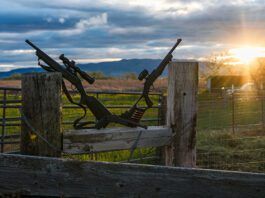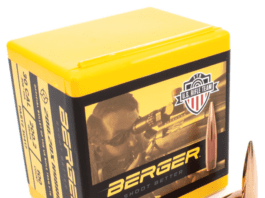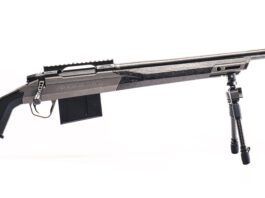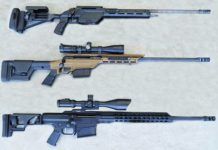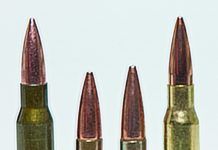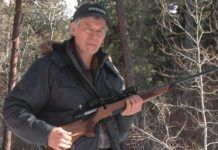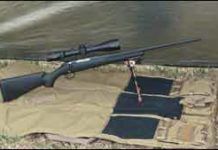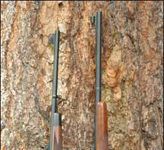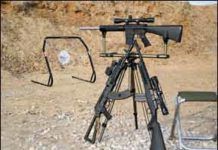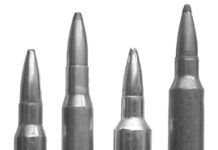Savage Axis II 300 Blackout
Ruger American Ranch Rifle 300 Blackout
CVA Cascade SB 300 Blackout
300 Win. Mag. Bolt Rifle Test: Savage, Steyr, Barrett Shoot Out
Rifles set up for long-range precision shooting are specialized instruments with features that allow the user to consistency wring out accuracy at or beyond 1000 yards. We recently looked at three precision rifles in the big-boy cartridge of 300 Winchester Magnum to see what hit our wallets had to take to get in on the fun of precision rifle shooting. At the low end of the price range, we tested a Savage 110 BA Stealth and two that were nearly four times the cost, a Steyr SSG 08 and Barrett MRAD. After the dust had settled, we determined the cost of the rifle did not make much difference in its accuracy performance. All rifles grouped sub minute of angle, requiring us to measure to two decimal places, or hundredths of an inch, to determine the top gun in accuracy. Spoiler: We shot the smallest group with the Savage. What separated the low-cost 110 BA Stealth from the premium-priced Barrett and Steyr were features that made the premium rifles easier to shoot or were more adaptive to the user's needs.
We went to MidwayUSA.com to fit the rifles with two affordable variable-power scopes and mounts. The first was a Bushnell Engage 4-16x44mm with Weaver Tactical Skeleton rings. The second was a Leapers UTG Accushot 4-16x56mm scope with a Bobro 1-Piece QD mount. The Engage scope uses what Bushnell calls a Deploy MOA reticle. We felt this scope offered clarity and sharpness. The locking turrets were easy to use and require no tools to adjust windage and elevation. We also liked the parallax adjustment, which we feel is a requirement for long-range shooting. The eyepiece was also easy to adjust and allowed different testers to dial in sharpness for their individual eyes. The magnification had just the right resistance so we could be on target and adjust magnification by feel, but not have to move out of position to make the optical changes we wanted. The Weaver rings are also a low-cost option that easily dealt with the recoil of the 300 Win. Mag. Since the Weaver set up used separate rings, we were able to ensure the Bushnell was well attached to the Picatinny rail of the Savage. The Leapers UTG Accushot 4-16x56mm performed similarly to the Bushnell but offered an illuminated reticle in either red or green, which some testers liked. A black reticle can be more difficult to aim on a black target. It featured a mil-dot reticle with a bubble leveler, letting the user know if the rifle is canted, which could affect the shot. Both scopes featured a second-focal-plane reticle, so the magnification needs to be set on a specific magnification for the reticle to be used in range estimation. The Bushnell needs to be dial to 16x, the highest magnification, and the Leapers needs to be dialed to 10x. In our opinion, the reticles and magnification ranges were suitable for long-range work, well over the yardage found at most public shooting ranges. We were pleased at the performance of both scopes.
Threaded-Barrel Bolt Guns In 300 Blackout and 308 Win.
A few years ago, the incidence of factory-supplied threaded barrels on rifles was negligible, because most people didn't have a lot of interest in changing their muzzle devices, including flash suppressors and sound suppressors. Sound suppressors, also incorrectly known as silencers, and more accurately called "mufflers" or "moderators," just weren't that common because the devices were regulated by the National Firearms Act (NFA) of 1934. In that law, Congress used its tax power to set up a tax-and-registration system for machine guns, short-barreled shotguns and rifles, grenades, mortars and various other devices, including sound suppressors.
Under the NFA today, a prospective owner must go through a months-long registration process with the Bureau of Alcohol, Tobacco, Firearms and Explosives (BATFE) and pay a $200 tax, in advance, before he or she can purchase a suppressor. Despite the difficulties posed by the regulatory system, suppressor sales have continued to grow over the last decade, and especially the last five years. Suppressor ownership is legal in most states. The exceptions are Hawaii, California, Illinois, New York, New Jersey, Delaware, Rhode Island, and Massachusetts. In the 42 states where suppressors are legal, they are allowed for hunting in all but Connecticut and Vermont, and states are de-regulating suppressor use every day, so this list may be outdated by the time you read this.
Concurrent with the sales growth of suppressors, manufacturers have responded by making the muzzles of some of their rifles and pistols easier to receive the devices. Thus, the growth of factory-threaded barrels, three models of which we recently tested, with and without a suppressor.
Special Report: Roessler Titan 6 Bolt-Action Rifle
It's not often we get a truly interesting rifle to test. Most are commonplace, and frankly carry little excitement for our test team. Once in a while a surprise comes along, and that's what happened recently. Houston Product Coordination Editor Kevin Winkle sent a rifle to Idaho that got our attention, and the more we looked into it, the more we liked it. This is the Roessler Titan 6, with interchangeable barrels in 300 Winchester Magnum and 270 Winchester (about $1980 for the rifle). The rifle came with no scope mounts and no iron sights, though both are available from the importer. There was, however, an excellent manual with the rifle printed on heavy stock that should last a long time. The receiver was a simple cylindrical type, and we guessed — correctly — that Remington Weaver-style bases would work on it. We used a Leupold 4X scope in Weaver rings for all our testing. We tested the gun with both barrels, using Remington and Winchester 180-grain loads in 300 Mag; and 130-, 140-, and 150- grain JSN Federal ammo in 270. Here's what we found.
243 Win. Bolt-Action Rifles Under $500: Ruger Vs Mossberg
Two 375 H&H Magnum Rifles: Winchester Versus Remington
Some time back a reader asked us which 375 H&H Magnum rifle we'd suggest for his son, who was going to Africa for an extended hunt. He wanted to know if the current crop of Winchesters and Remingtons were any good in that caliber, and which one we'd recommend for his son. We knew Winchester was producing a new Model 70 Winchester, made by FN in the U.S., but had examined only a Lightweight Compact 308 Model 70. We thought it was a pretty good rifle, but those who can make a good 308 cannot necessarily make a good 375. We knew Remington used to make a decent 375, and a quick search of the Remington website showed us a current offering in that caliber. We acquired a new Model 70 Winchester (MSRP $1400) and a new Remington 700 CDL 375 100th Anniversary Edition. (MSRP $1450) and put them to the test. We tested with Hornady Heavy Magnum 300-grain FMJ RN solids and 270-grain Hornady Heavy Magnum SP InterLock, and with handloads using 235-grain Speer Semi-Spitzer Hot Core, 270-grain Hornady Spire-Point, and 300-grain Nosler Partition bullets. Here are our findings.
Classic Military Bolt-Action Rifle Shootout: Lee Enfield Wins
During World War I and World War II, and in some cases beyond, there came four great bolt-action rifles in martial actions: the Lee Enfield, the Mauser, the Mosin Nagant and the Springfield. While there were many variations among the rifles, we all know what a Lee Enfield and a Mauser look like. The Nagant was produced in the many millions, and the Springfield is sometimes regarded as a rifle with almost magical accuracy. These rifles wrought many a bloody victory for one side or the other in warfare from about 1903 onward. The Lee Enfield and Mauser rifles are still seen in action in Afghanistan today. Recent events in India showed Indian security forces armed with the Lee Enfield, probably a homegrown version. These rifles simply refuse to die. While these four are the great battle rifles of the 20th century, there were other contenders for the test program that were considered and discarded. The excellent Schmidt Rubin straight-pull rifle was considered, but since it didn't figure into warfare it was not included. The French rifles are a bit quirky for our tastes, and ammunition is difficult to obtain. Likewise, the Italian Carcano is not really in the league with the others. We admit the Japanese Arisaka is an omission, but we were unable to find a suitable firing version within our time frame. We used four rifles primarily during the test program and added two special interest rifles for a side comparison as well. In the end we think we have a good idea of the handling properties of the rifles used in the Great Wars.
30-Caliber Carbines: SSKs 300 Whisper Speaks Volumes
Despite the long-standing availability of the AR-10, 30-caliber semi-automatic rifles continue to be less popular than the 5.56mm/223 Rem. AR-15 little brother. But just like the high-capacity 9mm pistol led to the popularity of more powerful high-capacity handguns, we're still interested in finding a good 30-cal carbine.
Our latest acquisitions in this quest began with Ruger's newest 7.62x39mm Mini-Thirty carbine, the $921 No. 5854. We wanted to see if shortening the barrel to a hair over 16 inches would make it a better choice. For the AK-47 adherents, we added a $1270 Colorado Shooting Sports Custom Combat Gen 2 AK-47 that featured the addition of a Lightning Bolt and Lightning Lever for improved combat readiness. Our third gun chambered the 300 Whisper, a round designed to be fired through a suppressor. Built by SSK Industries, this was a $1300 AR-15 platform capable of shooting both high-velocity and subsonic velocity rounds with the twist of a screw in the handguard.
Since our primary interest was close quarters battle, our accuracy tests were limited to benchrest shooting from the 50-yard line. But we also challenged the SSK Industries 300 Whisper to longer distances to learn more about this cartridge.
In addition, we had some very specific questions to answer that had more to do with the general "shootability" of these carbines, including rapid fire. We got some help practicing for shots of record from a couple of new products from Battenfeld Technologies.
They were Caldwell's $130 Dead Shot Field Pod and the $170 Magnum Rifle Gong. The Field Pod is an ultra lightweight collapsible shooting rest with a carry sling. We especially liked the gong because its frame broke down to 5 easy-to-carry pieces plus the durable AR550 steel plate. Ringing the gong gave our test evaluators immediate feedback and we didn't have to paste up targets. It was a lot of fun for our testers, too.
For optics we mounted the same Springfield Armory 3-9X40mm A.R.T. IV variable power scope on both the Ruger and SSK Industries carbines. The Colorado Shooting Sports AK-47 utilized a forward mount with an Aimpoint CompML2 with 4-MOA red dot mounted and sighted in by CSS. It seemed ideally suited to the weapon and was a better choice than any long-relief scope we could supply. In view of our relatively short test distance, we chose to leave it in place.
For ammunition we utilized four different rounds of 7.62x39mm ammunition. They were 124-grain soft point Wolf Military Classic, 124-grain FMJ American Eagle, Remington UMC 123-grain Metal Case, and Winchester 123-grain full-metal-jacket rounds. Our 300 Whisper ammunition consisted of three Cor-Bon rounds and three Hornady rounds. The Hornady rounds were the 110-grain VMax, 208-grain AMax, plus a handload topped with a Hornady 169-grain hollowpoint boattail bullet. The Cor-Bon rounds were 125-grain jacketed hollowpoint rounds, 220-grain Subsonic rounds and a 150-grain jacketed soft point. Unfortunately, we had difficulty chambering the 150-grain JSP rounds and returned them to Cor-Bon for analysis.
Two Speedy .30-Caliber Rifles: Tikkas T3 Lite .300 WSM Wins
The .300 Magnum is eternally popular, for reasons some of us don't fully understand. The .300s don't give you a lot more of anything—except expense—than you can get from the .30-06. Those wanting more rifle than the ‘06 are better served with larger bores, not just more gas. But many shooters don't understand that. Far be it from we gun testers to dictate the choices of those who like the blast of the various .30 magnums. Today there are a bunch of these, by Weatherby, Winchester (2), Dakota, Remington, and of course the original, by Holland & Holland, still viable after close to a hundred years. In this test we look at two cartridges in two rifles, the .300 WSM in Beretta's Tikka T3 Lite ($595), and the original .300 Winchester Magnum cartridge in Ruger's Hawkeye ($779). Both rifles are offered in at least two stock materials, synthetic or wood, and both have stainless-metal variants. We chose a synthetic-stocked, blued Tikka and the wood-stocked, blued Hawkeye. Let's take a look at how they stacked up.
Winchesters .300 WSM: Short And Fat Versus Long and Slim
Winchester's .300 WSM seems a bit strange to us. Its purpose would seem to be the achieving of a somewhat lighter rifle while maintaining the approximate performance of the .300 Winchester Magnum. With its 1/2-inch-shorter cartridge length, the .300 WSM's action can be half an inch shorter, too. Also, there's the matter of a shorter bolt throw, which implies a faster-operated rifle. Independent tests of these points by some friends of Gun Tests indicated they are not necessarily true. (They found identical rifle weights and bolt-operation times in a casual test of on-hand rifles.)

























